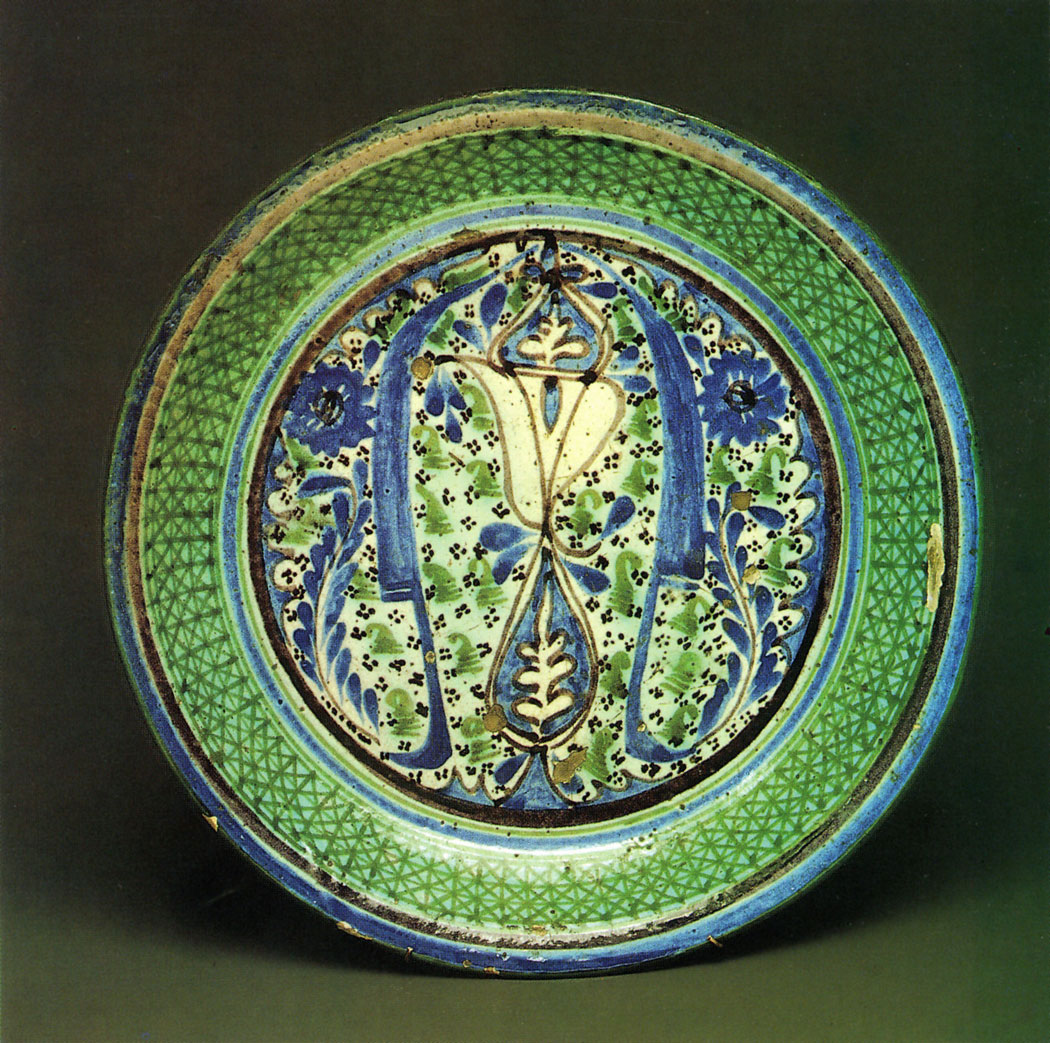
Tajikistan

Tavok dish
By Mir Gafur. Khojent, Tajikistan. 1916
Clay, painted and glazed.
Height 4.7 cm, diameter 31 cm. Inv. No. 2289 III
Acquired in 1937 from a private collection. First publication.
The pilau dish by Mir Gafur comes from Khojent, the ancient town of the Fergana valley, which retained its importance as a celebrated pottery-making centre up to the 20th century. Local ceramics in the late 19th and early 20th centuries are characterized by turquoise and blue painting against a white slip background. According to ancient oriental beliefs, blue symbolized the sky and water, i. e. happiness and life. The net-like ornamentation along the rim is traditional and goes back to the earliest unglazed Central Asiatic pottery of the 3rd-1 st millennia BC found at the sites of Anau in Turkmenia and Chust in Uzbekistan.
The appearance of concrete articles in the decor of the dish, a tea-pot (choidish) and two knives (kordiosh), reflects the general tendency toward concretizing the repertory of motifs and images, which manifested itself in Tajik and Uzbek art of the late 19th and early 20th centuries. According to local beliefs, a tea-pot and a knife are symbols of goodwill and welcome. The teapot on the platter was supposed to remind the host that after the rich pilau his guests should be treated to the healing beverage, tea. Knives since time immemorial had been honoured in Central Asia as talismans which protected people from evil spirits.
Kuzacha, a pot for sour milk
By Iskhakbibi Sanoyeva (born 1904). Village of Yegid, West Pamirs, Tajikistan. 1972
Clay, smoked and burnished, with applied decoration.
Height 10 cm, diameter 12 cm. Inv. No. 7425 III
Acquired in 1972 from the artist. First publication.
The kuzacha belongs to an archaic type of ceramic vessels made by peasant women of the West Pamirs by hand, without a potter's wheel. Such hand-moulded pottery was baked in an open fire and used as water arid food containers.
The village of Yegid whence the pot comes is among the best-known centres of hand-moulded pottery in the Pamirs. Like all wares from Yegid, the kuzacha is characterized by a deliberate functionality of form-it is squat, with a wide cylindrical neck and small ring-shaped handles. The vessel is not devoid of a certain artistic merit-its stocky form is expressive in its own way, its body is of a noble red-brown hue caused by the smoke of fire, and the ornamentation is appealing with its simple naivety of design. The applied decoration runs round the body of the vessel marking its junction with the neck. The roughness of the clay is smoothed by burnishing.
Kondar, a pot for sour milk
By Usmon Meliyev (born 1930). Village of Kanibadam, Tajikistan. 1970s
Clay, painted and glazed.
Height 22.5 cm, diameter 20 cm. Inv. No.5714 III
Acquired in 1969 from the artist.
Present-day potters of Kanibadam have adopted and successfully developed the traditions of the North Tajikistan school of pottery-making, particularly, of its most celebrated 19th-century centre, Khojent.
Usmon Meliyev, one of the most active and prolific craftsmen of Kanibadam, comes from a family which has produced several generations of potters. His creations are varied in form and function. Among his most interesting works are kosas (large bowls) and various vessels with lids. The typical decor of his vessels consists of stylized plant and geometric patterns in turquoise-green, blue and pink-brownish tints against a light pinkish background. The representational motifs usually dominate the decor, in which exotic bouquets, spirals, rosettes and arches cover the entire external surface of the vessels.
|
ПОИСК:
|
© MUSEUMS.ARTYX.RU, 2001-2021
При использовании материалов сайта активная ссылка обязательна:
http://museums.artyx.ru/ 'Музеи мира'
При использовании материалов сайта активная ссылка обязательна:
http://museums.artyx.ru/ 'Музеи мира'